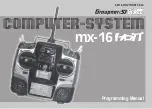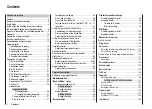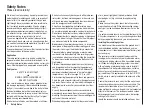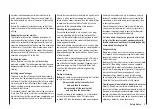
5
Safety Notes
Ensure that no metal parts are able to rub against each
other, e. g. when controls are operated, when parts
rotate, or when motor vibration affects the model. Metal-
to-metal contact causes electrical “noise” which can
interfere with the correct working of the receiver.
Directing the transmitter aerial
Transmitter field strength is at a minimum in an imagi-
nary line extending straight out from the transmitter
aerial. It is therefore fundamentally misguided to “point”
the transmitter aerial at the model with the intention of
obtaining good reception.
When several radio control systems are in use on adja-
cent channels, the pilots should always stand together in
a loose group. Pilots who insist on standing away from
the group endanger their own models as well as those
of the other pilots.
However, if two or more pilots operating 2.4 GHz radio
control systems stand closer together than 5 m, the
down-link channel may be swamped, triggering a very
premature range warning. If this should occur, walk
away from the other pilots until the range warning
ceases again.
Pre-flight checking
Before
you switch on the receiver, ensure that the throt-
tle stick is at the stop / idle end-point.
Always switch on the transmitter first,
and only then the receiver.
Always switch off the receiver first,
and only then the transmitter.
If you do not keep to this sequence, i. e. if the receiver
is at any time switched on when “its” transmitter is
switched OFF, then the receiver is wide open to signals
from other transmitters and any interference, and may
respond. The model could then carry out uncontrolled
movements, which could easily result in personal injury
or damage to property.
Please take particular care if your model is fitted with
a
mechanical gyro
: before you switch your receiver off,
disconnect the power supply to ensure that the motor
cannot run up to high speed accidentally.
As it runs down, the gyro can generate such a high
voltage that the receiver picks up apparently valid
throttle commands, and the motor could respond by
unexpectedly bursting into life.
Range checking
Before
every
session check that the system works properly
in all respects, and has adequate range.
Secure the model
adequately, and ensure that no persons are standing in
front of the model.
Before you fly the model, carry out at least one complete
check of all the working systems, and one complete
simulated flight, in order to eliminate any possible sys-
tem faults or model programming errors. In this regard it
is essential to read the notes on pages 80 and 89.
When operating a model, i. e. when flying or driving,
do not operate the transmitter without the aerial fitted.
Check that the transmitter aerial is firmly seated.
Operating your model aircraft, helicopter, boat or car
Never fly directly over spectators or other pilots, and
take care at all times not to endanger people or animals.
Keep well clear of high-tension overhead cables. Never
operate your model boat close to locks and full-size ves-
sels. Model cars should never be run on public streets or
motorways, footpaths, public squares etc..
any other installed equipment in the model, but in an
easily accessible position. Under no circumstances al-
low servo leads to run close to the aerial, far less coiled
round it!
Ensure that cables are fastened securely, so that they
cannot move close to the receiver aerial when the model
is flying.
Deploying the receiver aerial(s)
The receiver and its aerials should be installed as far
away as possible from all kinds of power system. If your
model has a carbon fibre fuselage, the aerial tips must
always be deployed outside the fuselage. The orientation
of the aerial(s) is not critical, but we recommend install-
ing them vertically (upright) in the model. If the receiver
features aerial diversity (two aerials), the second aerial
should be arranged at 90° to the first.
Installing the servos
Always install servos using the vibration-damping
grommets supplied. The rubber grommets provide some
degree of protection from mechanical shock and severe
vibration.
Installing control linkages
The basic rule is that all linkages should be installed in
such a way that the pushrods move accurately, smoothly
and freely. It is particularly important that all servo output
arms can move to their full extent without fouling or rub-
bing on anything, or being obstructed mechanically at
any point in their travel.
It is essential that you should be able to stop your motor
at any time. With a glow motor this is achieved by adjust-
ing the throttle so that the barrel closes completely when
you move the throttle stick and trim to their end-points.
Summary of Contents for mx-12 Hott
Page 1: ...Programming Manual 33116 mx 16 HoTT 3 en mx 16...
Page 35: ...35 For your notes...
Page 49: ...49 For your notes...
Page 55: ...55 For your notes...
Page 59: ...59 For your notes...
Page 63: ...63 For your notes...
Page 69: ...69 For your notes...
Page 91: ...91 For your notes...
Page 101: ...101 For your notes...
Page 123: ...123 For your notes...
Page 181: ...181 For your notes...
Page 193: ...193 For your notes...






































